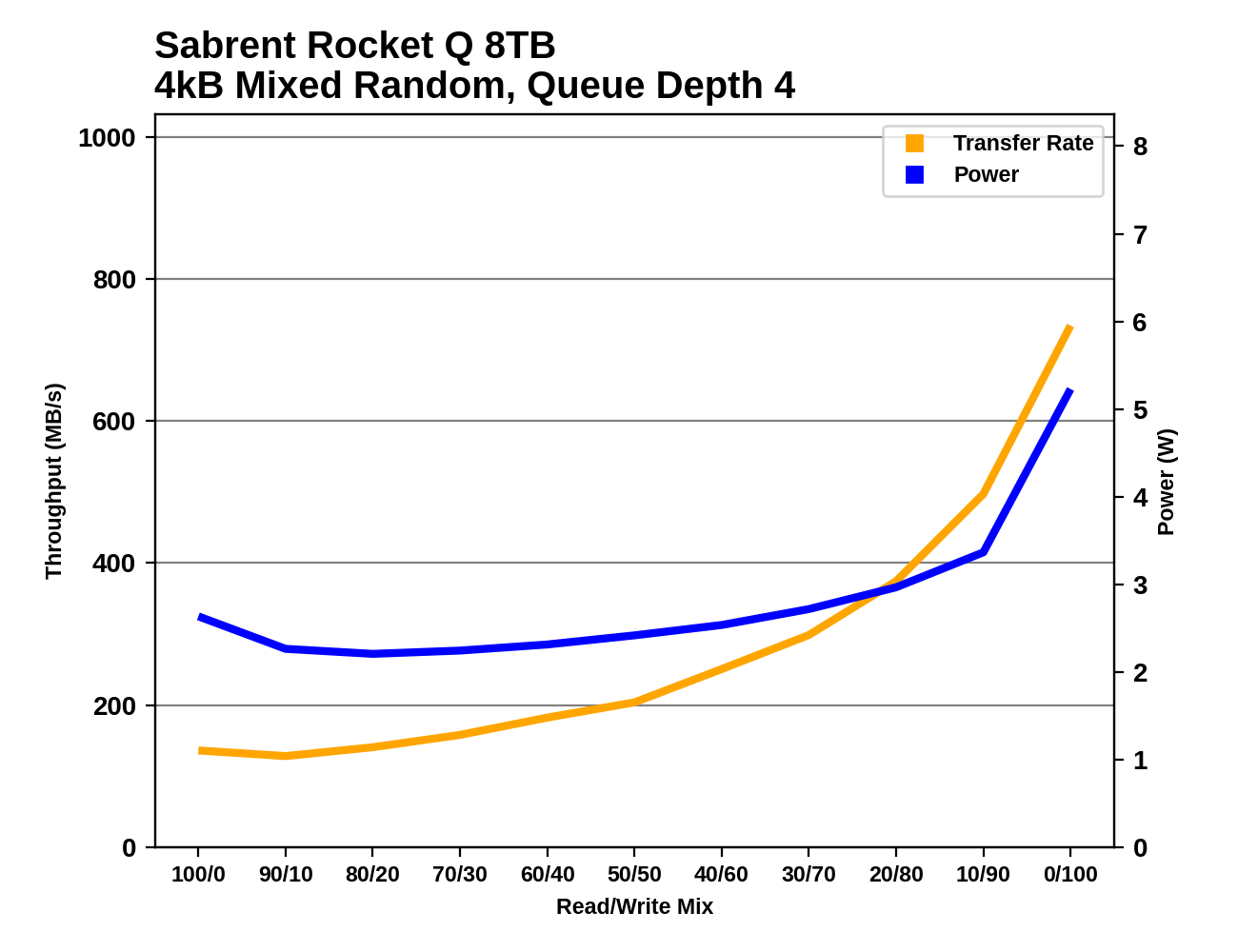QLC Goes To 8TB: Samsung 870 QVO and Sabrent Rocket Q 8TB SSDs Reviewed
by Billy Tallis on December 4, 2020 8:00 AM ESTMixed Random Performance
Our test of mixed random reads and writes covers mixes varying from pure reads to pure writes at 10% increments. Each mix is tested for up to 1 minute or 32GB of data transferred. The test is conducted with a queue depth of 4, and is limited to a 64GB span of the drive. In between each mix, the drive is given idle time of up to one minute so that the overall duty cycle is 50%.

The 8TB Sabrent Rocket Q's performance on the mixed random IO test is much better than any of the other low-end NVMe drives; the DRAMless TLC drives are the slowest in this bunch, and the Intel 660p with its four-channel controller cannot keep up with the Rocket Q's 8-channel Phison E12. The 8TB Samsung 870 QVO is slower than most of the other SATA drives in this bunch, but still has a clear advantage over the 1TB model.
 |
|||||||||
| Power Efficiency in MB/s/W | Average Power in W | ||||||||
The high-end consumer NVMe drives and the Samsung 860 EVO TLC SATA drive top the power efficiency chart for the mixed random IO test. The Sabrent Rocket Q's efficiency is a significant step down from there, but still a bit better than any of the other low-end drives. The 8TB 870 QVO's efficiency score is worse than the 4TB model's, but clearly better than the 1TB model or either of the DRAMless TLC NVMe drives.
 |
|||||||||
Both of the 8TB QLC drives show fairly typical performance curves for the mixed random IO test: little or no performance drop when writes are first added to the mix, and then increasing performance that accelerates toward the end of the test as write caching becomes more effective. The 8TB 870 QVO doesn't show the signs of a filled SLC cache that we see from the 1TB model, and neither 8TB QLC drive shows the nearly-flat performance exhibited by the two DRAMless TLC drives.
Mixed Sequential Performance
Our test of mixed sequential reads and writes differs from the mixed random I/O test by performing 128kB sequential accesses rather than 4kB accesses at random locations, and the sequential test is conducted at queue depth 1. The range of mixes tested is the same, and the timing and limits on data transfers are also the same as above.

The Sabrent Rocket Q's performance on the mixed sequential IO test is competitive with the high-end consumer TLC drives, and far better than the other low-end NVMe options. The 8TB Samsung 870 QVO has distinctly lower performance than the smaller capacities, but isn't quite the worst overall performer.
 |
|||||||||
| Power Efficiency in MB/s/W | Average Power in W | ||||||||
The good performance of the Rocket Q on the mixed sequential IO test comes at the cost of worse power efficiency than the DRAMless TLC competition, but its efficiency scores are still decent. The 8TB 870 QVO's efficiency scores are worse than any of the other consumer SSDs in this bunch.
 |
|||||||||
As with several other synthetic tests in our suite, the mixed sequential IO test has the Sabrent Rocket Q showing rather variable performance, though fortunately without any severe drops. It performs a bit better during the more write-heavy half of the test.
The Samsung 870 QVO shows relatively flat and consistent performance throughout this test, but as is common for Samsung drives there's a bit of a decreasing performance trend during the read-heavy half of the test.










150 Comments
View All Comments
inighthawki - Friday, December 4, 2020 - link
For sure. By all means I'm not expecting this to be a requirement any time soon. I just wanted to point out an upcoming reason that high capacity M.2 drives may be of value. Even right now I'm using a 4TB HDD, but for my upcoming build I was considering the 8TB sabrent drive just for future proofing.PopinFRESH007 - Friday, December 4, 2020 - link
Any idea if/when you’ll review the Sabrent 4 Plus? Interested to see how it stacks up with the 980 ProBilly Tallis - Friday, December 4, 2020 - link
I don't have the Rocket 4 Plus or another Phison E18 in hand yet. I'm almost ready to launch the new PCIe gen4 test suite, but the first few reviews with that will be stuff like the Rocket Q4, WD Black SN850 and ADATA S50 Lite (with those reviews including new test results for Phison E16 drives and the 980 PRO). So I probably won't be able to get around to a Phison E18 drive until January.Beaver M. - Saturday, December 5, 2020 - link
Others have tested it. It is good, but not quite as good as the SN850 or 980 Pro.lilmoe - Friday, December 4, 2020 - link
With MLC drives so close in price, you've got to be crazy to even consider a QLC drive.lilmoe - Friday, December 4, 2020 - link
TLC**Dug - Friday, December 4, 2020 - link
The price difference is significant at 4TB and 8TBlilmoe - Friday, December 4, 2020 - link
Do you really want to put 4-8 TB of data into one single, 3rd rate drive?TheinsanegamerN - Saturday, December 5, 2020 - link
With games like the new COD eating up over 250GB for a single game, that 4-8TB may not feel as large as you think.People made the same argument with 2TB SSDs years ago.
Deicidium369 - Saturday, December 5, 2020 - link
Well if you are smart you have a backup and not that SPOF